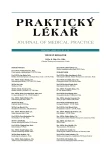Risk factors for the development of insulin resistance
Authors:
D. Horáková 1; E. Sovová 2; D. Pastucha 2; R. Benešová 3; H. Kollárová 1
Authors‘ workplace:
Přednosta: doc. MUDr. Arnošt Martínek, CSc.
; Přednosta: doc. MUDr. Eliška Sovová, Ph. D., MBA
; Přednosta: doc. MUDr. Helena Kollárová, PhD.
; Ústav preventivního lékařství LF UP Olomouc
1; Klinika tělovýchovného lékařství a kardiovaskulární rehabilitace LF a FN Olomouc
2; Interní klinika LF a FN Ostrava
3
Published in:
Prakt. Lék. 2011; 91(10): 599-602
Category:
Of different specialties
Overview
Background:
The basic components of metabolic syndrome include
– abdominal obesity,
– impaired glucose metabolism,
– atherogenic dyslipidaemia, and
– arterial hypertension.
These symptoms tend to combine and their causal association with insulin resistance is assumed. In a group of obese individuals, the study demonstrates the presence of risk metabolic parameters, signalling early insulin resistance and potentially leading to the diagnosis of metabolic syndrome in the near future.
Methods and results:
Two groups were analyzed:
– a group of healthy individuals (A, n=122), and
– a group of obese individuals (B, n=213).
Obese subjects in Group B have parameters that suggest early insulin resistance:
– hypertension,
– hyperglycaemia,
– increased triglyceride levels,
– lower adiponectin levels, and
– higher aFABP levels
as compared with healthy individuals.
The QUICKI index values in Group B are also typical for early insulin resistance (0.305). The highest correlation was between aFABP and BMI (0.57).
Conclusions:
Early diagnosis of metabolic syndrome is crucial for decreasing morbidity of populations. The presence of obesity in association with higher glucose and triglyceride levels and hypertension significantly increases the risk of gradual development of insulin resistance
Key words:
insulin resistance, metabolic syndrome, obesity.
Sources
1. Bronský, J., Nevoral, J., Průša, R. Adiponektin – marker inzulinové senzitivity. Čs. fyziol., 2005, 54, s. 92-96.
2. Devaraj, S., Singh, U., Jialal, I. Human C-reactive protein and the metabolic syndrome. Curr. Opin. Lipidol. 2009, 20(3), p. 182-189.
3. Hamdy, O., Porramatikul, S., Al Ozairi, E. Metabolic obesity: the paradox between visceral and subcutaneus fat. Curr. Diabetes Rev. 2006, 2, p. 367-373.
4. Kahn, S.E., Haffner, S., M., Viberti, G. et al. Rosiglitazone decreases C-reactive protein to a greater extent relative to glyburide and metformin over 4 years despite greater weight gain: observations from a Diabetes Outcome Progression Trial. Diabetes Care 2010, 33(1), p. 177-183.
5. Katz, A., Nambi, S., Mather, K. et al. Quantitative insulin sensitivity Cheb index a simple accurate method for assesing insulin sensitivity in humans. J. Clin. Endocrinol. Metab. 2000, 85, p. 2402-2410.
6. Kintscher, U., Hartge, M., Hess, K. et al. T-lymphocyte infiltration in visceral adipose tissue: a primary event in adipose tissue inflammation and the development of obesity-mediated insulin resistence. Arterioscl. Thromb. Vasc. Biol. 2008, 28, p. 1304-1310.
7. Kolb, H., Mandrup-Poulsen, T. The global diabetes epidemic as a consequence of lifestyle-induced low-grade inflammation. Diabetologia 2010, 53, p. 10-20.
8. Mayer, O., Cífková, R., Filipovský, J. a kol. Prevalence asymptomaticky vysokého rizika kardiovaskulárních chorob ve vzorku obecné české populace a adherence k doporučeným cílovým hodnotám primární prevence. Prakt. Lék. 2010, 90(4), s. 230-234.
9. Ryo, M., Nakamura, T., Kihara S. Adiponectin as a biomarker of the metabolic syndrome. Circ. J. 2004, 68, p. 975-981.
10. Stefanska, A., Sypniewska, G., Blaszkiewicz, N. et al. Comparison between C-reactive protein and adipocyte fatty acid-binding protein as a komponent of metabolic syndrome in middle-aged women. Clin. Biochem. 2011, 44(4), p. 304–306.
11. Svačina, Š. Poruchy metabolismu a výživy. Praha: Galén, 2010, s. 229.
12. Škrha, J. Diabetes mellitus 2. typu jako subklinický zánět. Čas. Lék. Čes. 2010, 149(6), s. 277-280.
13. Tso, A., W., Xu, P., C., Sham, M. N. et al. Serum adipocyte fatty acid binding protein as a new biomarker predicting the development of type 2 diabetes. Diab. Care 2007, 30, p. 2667-2672.
14. Xu, A., Wang, Y., Xu, J., Y. et al. Adipocyte fatty acid-binding protein is a plasma biomarker closely associated with obesity and metabolit syndrome. Clin. Chem. 2006, 52, s. 405-413.
Labels
General practitioner for children and adolescents General practitioner for adultsArticle was published in
General Practitioner

2011 Issue 10
Most read in this issue
- Probiotics from the view of general practitioner – bacteria species used as a probiotics, their effect, safety and dosage
- Primary hyperparathyreosis due to an ectopic parathyroid adenoma in the upper mediastinum as a cause of hypercalcaemia: case report
- Recurrence of thromboembolic disease and the possibility of its prevention
- Sexuality of seniors.
